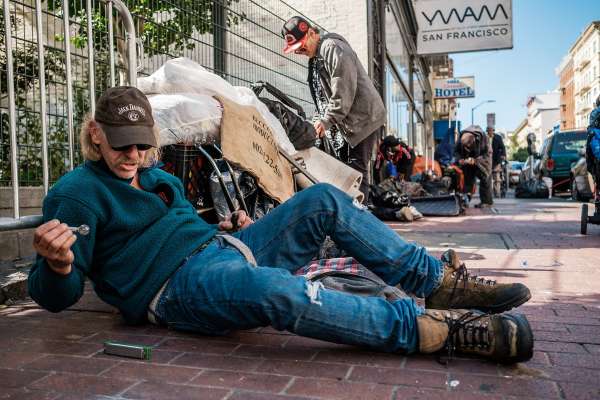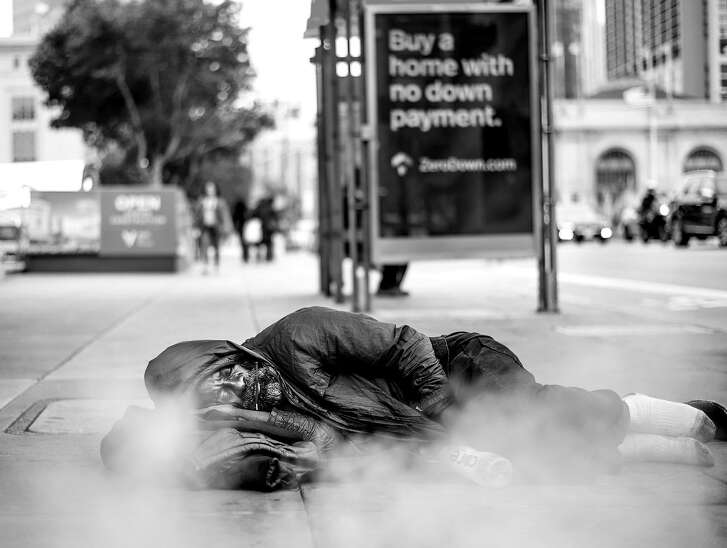Meth devilishly hard to kick for addicts: ‘No effective treatment’


As she sat on Turk Street sucking in a deep pull from her lit “bubble,” or methamphetamine pipe, Roche shook her head.
“Kick meth? Are you kidding?” she said. Roche, a 20-something who said she only goes by the one name in the streets where she sleeps, blames her homelessness, her nagging cough and her constant jitters on meth. But she said she feels there is nothing she can do about it.
“When it’s got you, it’s got you,” she said. “I have about 10 friends who are dead from smoking this — and not just from fentanyl being in it — and someday that will probably be me.”
Doctors feel just as confounded as Roche does about the meth epidemic, which has long been a widespread crisis in San Francisco’s homeless community, destroying countless lives. While meth has been a problem for more than two decades, city officials say they’ve seen a huge uptick in its use over the past decade, and it’s contributed to what is widely seen as a mental health crisis on the city’s streets.
Officials announced plans last week for developing a meth sobering center in an attempt to move addicts off the street. But getting users into effective treatment won’t be as easy.
More on Meth Epidemic
The drug is probably the hardest to treat for addiction, they say, largely because there is no replacement medication, such as methadone, which helps stave off cravings for heroin.
Even crack cocaine, which also has no replacement medication, is easier to kick than meth, most experts agree.
“It’s a super frustrating place for a physician to be in,” said Dr. Josh Bamberger, a longtime street addiction specialist and assistant director of the Benioff Homelessness and Housing Initiative research institute at UCSF. “The take-home lesson is that we have no effective medical treatment for amphetamine addiction.
“We’ve tried so many medications — antipsychotics, antidepressants, Adderall and more, but none of them has a long-term impact on the addiction. It is very hard to treat.”
He said one of the best rehabilitation techniques is called “contingency management,” in which addicts are paid to stay clean, with the amount going up every week. One key — as with any substance abuse treatment program, he said — is to get addicts housed first, if they aren’t already.
“You pay $10 one week, $20 the next, and so on,” Bamberger said. “Then if you run the table and go 11 or 12 weeks without using, you have a good chance of staying clean. It’s not great, but it seems to be the best way right now.”
He said the city’s plan for a sobering center for meth addicts experiencing crises is good for several reasons, including that it will relieve stress on the more expensive hospital emergency rooms.
“Overall, it takes about 12 to 24 hours to come down from acute methamphetamine intoxication, and a sobering center can be useful for that,” he said.
“However, some people continue to exhibit psychotic behavior for days, or even months. And that can involve not just paranoid delusions, but also formication (named after the formic acid ants exude), where you feel you have ants or worms under your skin. It’s awful.”
He said one particularly disturbing effect of intensive methamphetamine use is that the change it makes in brain chemistry is “acute, and it can be long term.”
“It can ‘concretize’ existing mental conditions,” Bamberger said, meaning worsen them in hard-to-reverse ways. “In my 30 years of practice in San Francisco, there is no question that my least favorite drug is methamphetamine.”
Kevin Fagan is a San Francisco Chronicle staff writer. Email: kfagan@sfchronicle.com Twitter: @KevinChron

 Pathways Drug Rehabilitation Luxury Addiction Treatment & Detox Center
Pathways Drug Rehabilitation Luxury Addiction Treatment & Detox Center


